#kangaroo population
Text
One of my alltime hobbies is moving into small rental homes in posh neighbourhoods so I can sit on the front porch in my fat, hairy, transgender glory, punching out joints and blasting slayer from the little portable Bluetooth speaker. These rental prices will be lowered and if you want a job done right, you gotta do it yourself
#the population of places ive lived as an adult always tend to go like. rich old white people or nepo baby couple with their first child#so it is my duty to be the fat hairy baked loud bogan neighbour#with the word bogan im always like. the rest of the world knows that right? like i feel like id be explaining kangaroos at that point#but incase anyone doesnt know its the australian equivalent of redneck (i grew up in the country and am being self deprecating)
4 notes
·
View notes
Text
Finalists of the 2023 Comedy Wildlife Photography Awards

Dispute by Jacek Stankiewicz from Kraków, Poland: 'I caught this scene while watching birds in the Bialowieza Forest. Young greenfinch was still fed by parents. However, from time to time birds looked like having argument. My friends interpret this scene in two ways: A young naughty kid is arguing with a parent. Or one kid is reporting to the parent that its brother did something wrong: "Look he has broken the glass in the window"'

'Excuse me sir but I think you're a little too young to be smoking' by Dakota Vaccaro from Victor, United States: 'While I was working deep in the Virginian woods, a family of grey foxes took up residence under the deck of the abandoned cottage next to my work housing. One day while practicing their hunting skills on bits of moss and branches, one of the kits lunged at a small chunk of wood and started rolling around with his prize. Tired after his hunt the kit lounged on his belly still holding the wood in his mouth which gave the strong resemblance of a cigar. I was very envious of the kit at this moment cause who wouldn't want to just lay around all day relaxing'

The Rainforest Dandy by Delphine Casimir from Brussels, Belgium: 'This picture was taken in the monkey forest in Ubud, Bali. This place is a crazy place where monkeys are king! Sometimes they give a show, sometimes they climb on you to look for fleas or steal the piece of biscuit you are trying to eat'
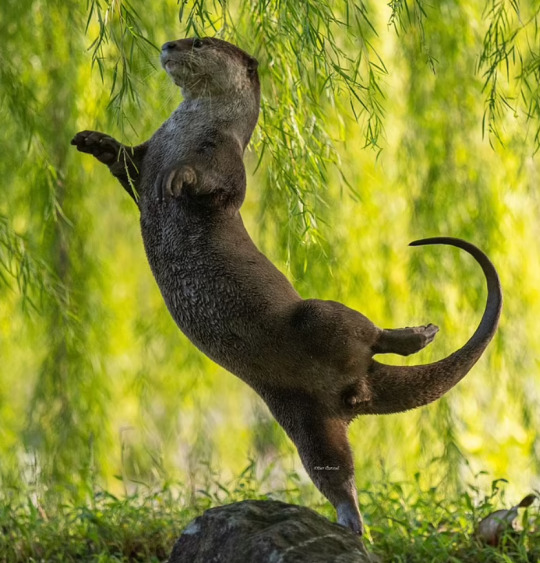
Otter Ballerinas by Otter Kwek from Singapore: 'An arabesque smooth coated otter'
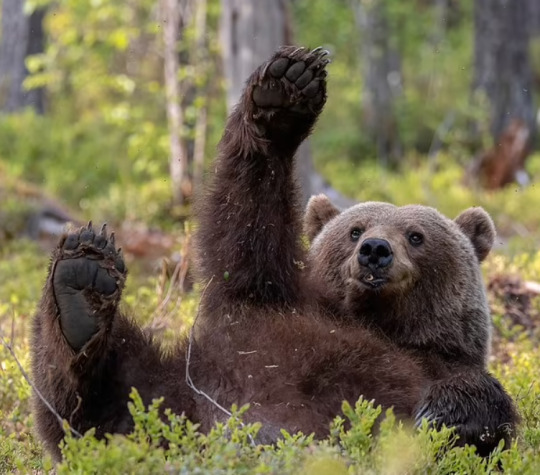
Picture me! Picture me!! by Dikla Gabriely from Yokneam, Israel: 'A brown bear in Finland who definitely did everything to make me pay attention to him and focus on him and not the other bears'

Boing! by Lara Mathews from Melbourne, Australia: 'Taken at Westerfolds Park, a beautiful and surprisingly wild pocket of land in the eastern suburbs of Melbourne, famous for its kangaroo population. The mob was enjoying some morning sunshine when this joey decided to get silly and try his hand at boxing'
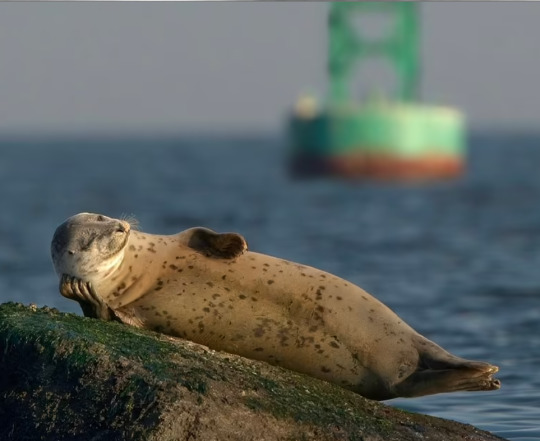
Living the Moment by Kawing Chiu from Staten Island, United States: 'Relax, lay back and enjoy the warm sun... This seal is scratching its face and it is seen lying on the side while his head is supported by his flipper. This image makes the seal like the reclining Buddha statue'
26K notes
·
View notes
Text
Kangaroo Nation: Celebrate and Conserve on National Kangaroo Awareness Day

Australia, known for its unique and diverse wildlife, holds a special place in the hearts of nature enthusiasts and conservationists alike. Among its iconic creatures, the kangaroo stands out as a symbol of strength, resilience, and the country's untamed beauty. To honor and bring attention to these fascinating marsupials, Australia celebrates National Kangaroo Awareness Day, a day dedicated to raising awareness about kangaroos and promoting their conservation.
The Kangaroo: A National Symbol
The kangaroo is not just an animal; it's a national symbol deeply embedded in Australia's identity. These marsupials are not only fascinating in their evolutionary design but also crucial to the ecological balance of the continent. Kangaroos have adapted to the harsh Australian landscape, displaying remarkable stamina and agility. With their distinctive hopping gait and powerful hind legs, they traverse the vast expanses of the Outback with ease.
National Kangaroo Awareness Day: A Time for Celebration
Every year on National Kangaroo Awareness Day, Australians come together to celebrate the unique attributes of these marsupials. Festivities include educational programs, community events, and wildlife exhibitions that highlight the importance of kangaroos in Australia's ecosystems. From schools to local communities, people of all ages participate in activities designed to deepen their understanding of these iconic creatures.
Festivities often include guided tours to kangaroo habitats, allowing participants to observe these marsupials in their natural environment. Experts and conservationists share their knowledge about kangaroo behavior, biology, and the challenges they face in the modern world. Celebrations also emphasize the role of kangaroos in Aboriginal culture, recognizing their significance in traditional stories and art.
Conservation Challenges
While National Kangaroo Awareness Day is a time for celebration, it also serves as a reminder of the conservation challenges facing these marsupials. Human activities, habitat loss, and climate change pose threats to kangaroo populations. Efforts to raise awareness about these challenges aim to inspire action on a broader scale.
Conservationists use the occasion to emphasize the importance of sustainable practices and responsible land management. Advocacy for the protection of kangaroo habitats, as well as research into their behavior and population dynamics, plays a crucial role in ensuring the long-term survival of these iconic creatures.
Getting Involved in Conservation
National Kangaroo Awareness Day encourages individuals to get involved in conservation efforts. Whether through supporting wildlife organizations, participating in habitat restoration projects, or simply spreading awareness on social media, everyone can contribute to the well-being of kangaroo populations.
Local communities often organize volunteer programs, inviting residents to participate in activities such as tree planting, habitat restoration, and wildlife monitoring. These hands-on experiences create a sense of connection between people and the natural world, fostering a collective responsibility for the conservation of Australia's unique biodiversity.
Looking to the Future
As we celebrate National Kangaroo Awareness Day, it is essential to reflect on the broader context of wildlife conservation. The challenges facing kangaroos are representative of the broader issues confronting ecosystems worldwide. By focusing our attention on these iconic marsupials, we can inspire a collective commitment to preserving biodiversity and maintaining the delicate balance of our planet.
In the years to come, National Kangaroo Awareness Day will continue to play a vital role in fostering appreciation, understanding, and action for the protection of kangaroos and their habitats. By coming together as a nation and as global citizens, we can ensure that future generations will have the privilege of marveling at these extraordinary creatures in the wild.
#national kangaroo awareness day#kangaroo awareness day#kangaroos#kangaroo habitat#kangaroo populations#kangaroo conservation
0 notes
Text
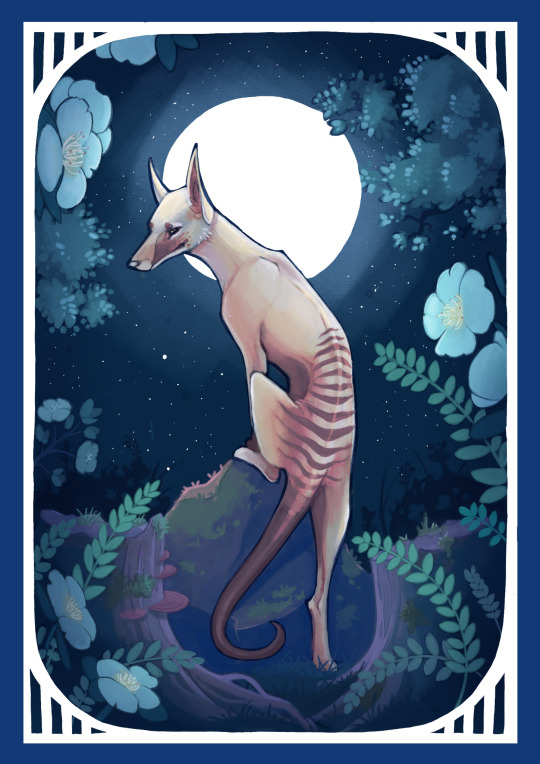
Extinction series number 3! The Thylacine!
More commonly known by the misleading names Tasmanian wolf or Tasmanian tiger, this stripey guy was actually a marsupial. Y'know, like a kangaroo.
Unlike the two previous animals, the thylacine's story doesn't have a happy ending. They went extinct in the 1930s thanks to excessive hunting in the name of pest control, habitat destruction, and the introduction of new diseases carried by imported domesticated animals.
Some people hold out hope that there might be a small, undiscovered population still out there somewhere, but at this point that isn't looking super likely 😔
#my art#digital art#art#artists on tumblr#digital painting#conservation#thylacine#tasmanian tiger#tasmanian wolf#animal art#animal#nature#nature art#moon#full moon
2K notes
·
View notes
Text
Let's talk about spring hounds!
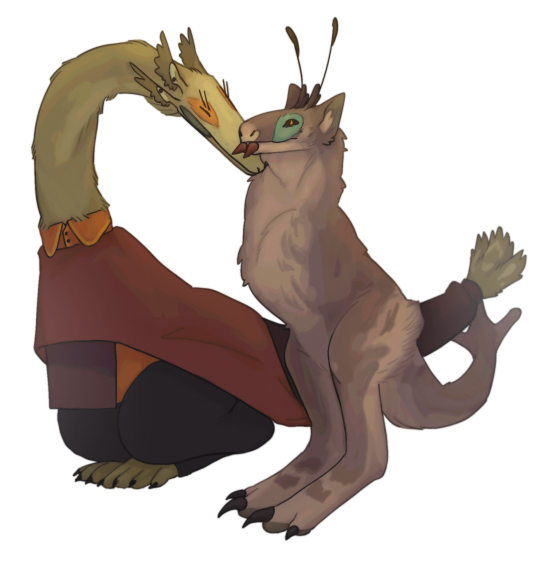
Spring hounds are the analog for dogs on Aurum, occupying a similar niche to wolves. They became domesticated a lot later than ours did, having become genetically distinct from their ancestors about 20,000 years ago. Because of this, along with other factors, they aren’t as physically diverse as our dogs are, but they fill many different niches and do have distinct breeds.
Remains of their ancestor species were found in singer burial grounds as far back as around 48,000 years ago! That’s around 20,000 years before Aurum’s last mass extinction event! The working theory for why it took them so long to become their own species is that bands of C singers would kidnap pups and raise them as their own on occasion. Since that was uncommon at the time, domestication just didn’t have the chance to come about until later.
Later on, because of an asteroid impact, populations of most species dropped drastically or completely disappeared. Spring hounds ancestors had a hard time coping with the post-impact world, and taking more scraps from the species who can hunt large game seemed very alluring. Over the next few thousand years, as the two singer species started to get more and more intertwined, spring hounds changed a lot. Close proximity to C singers made them much more sociable, trainable, and visually appealing (yay neoteny).
The reason why working with this species specifically was so appealing to Cs was the difference in their hunting methods. Cs are ambush predators, they can reach extremely high speeds, but not for very long. Spring hounds are endurance predators, they can pursue prey for much longer. When whatever is being hunted tries to escape, spring hounds are there to cut them off or herd them back to the hunting party. It's a system that benefits both, and that forged a deep bond between the two species.
Spring hounds still exist in the modern day, they're a very common working animal and even more common companions. It's common practice for Cs who give birth to only one child to get their child a spring hound pup to play and socialize with.
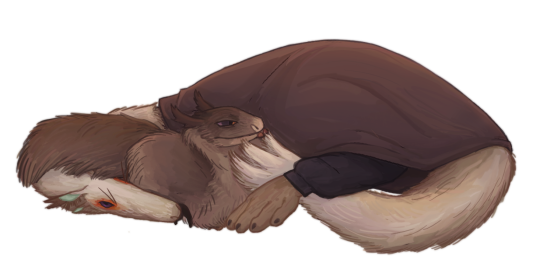
E singers also keep them as pets, but their relationship with them is similar to our relationship with cats. Spring Hounds are slightly intimidated by Es size, and Es have a harder time forming bonds with them because of this. However, they are still pretty popular pets, and the two can form close bonds with each other like Cs can. Es just need to approach them with more patience and understanding.
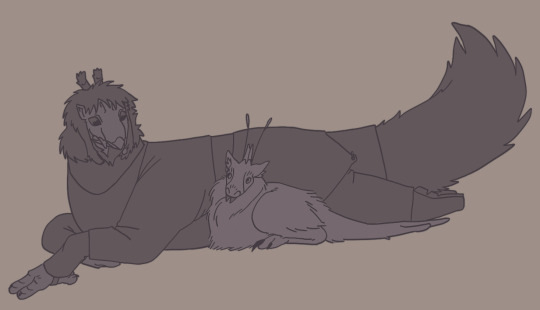
Biology

With strong legs, stocky bodies, and mouths full of sharp teeth, spring hounds make formidable predators. Their body plan is similar to that of a kangaroo because of their shared need for endurance. They can hop at a stable speed for miles, pursuing prey until the exhaustion overcomes them.
Their tail has the same 3 segments most members of their class do, and it's used as a leg when they aren’t moving. The only exception to this is the awkward shuffle they do to move very short distances.
Their feet have one large claw to hook onto prey while they hold them down. Since they hunt in packs, they use their collective weight to hold down whatever they catch.
Large ears give them great hearing, allowing them to be alerted to things moving a considerable distance away from them. The long, thin feathers on their head are connected to recessive ears, which evolved to be used for communication and courtship.
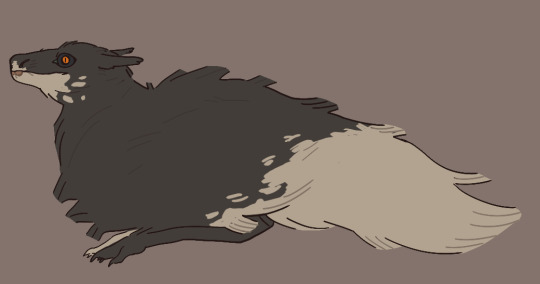
Spring pups are much fluffier, lacking the tusks and open ears of an adult hound. Their young are more altricial than Cs, and are unable to walk or hear for a few weeks after they are born. The two parents of the pups will take turns watching over the litter while the other one hunts. They can start eating meat after a couple of days but cannot crack through shells and bones until they're older.
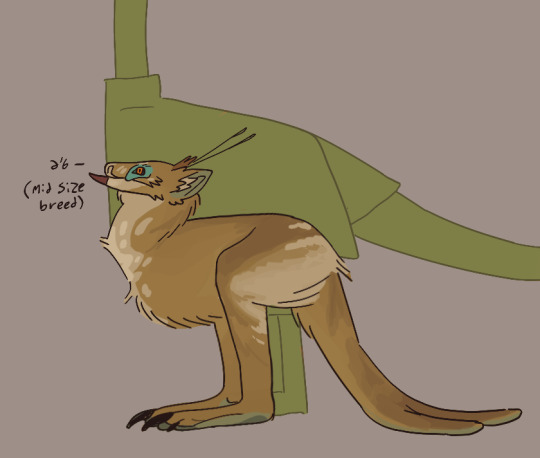
On average an adult spring hound is about 2-3 feet tall, but some breeds get closer to 1 or 4 feet.
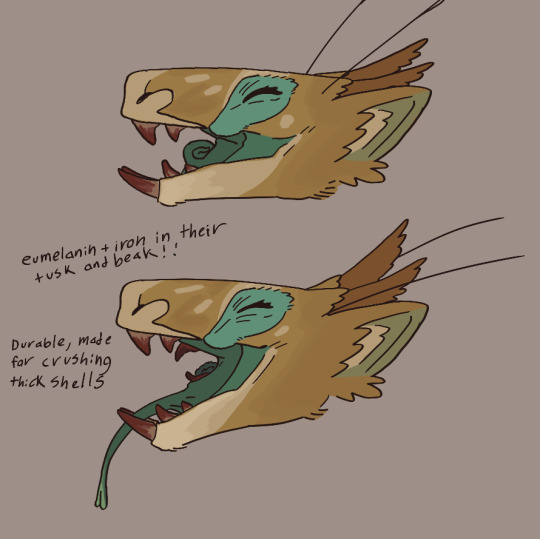
Their mouths are a bit overcomplicated, again like most animals in their class. One thing that sets them and the species closely related to them apart is the fact they are both carnivorous and have external tusks. The external tusks are not really for hunting, but for manipulating and holding onto carrion, and for building nests. Unlike their internal tusks, the external ones can move slightly up and down. They'll hold objects between their external tusks and tongue, and while they don't have the strongest grip, it makes up for their lack of forelegs or arms. The internal ones are used for hunting, so they’re are more firmly set in the jaw and are much sharper. Their beak is the real star of the show, however, it's the strongest part of their mouth and can bite through a lot of the harder parts of the animals they eat. In households, they have a bad habit of biting chair legs in half that are too thin if they don't get trained to use a designated chew toy. The “tongue” inside is a radula, and it's covered in thousands of teeth.

Their eye color ranges from yellow to red, but their sclera is usually the same shade of very dark blue. Similarly to c singers, their eyes are not round, and are instead eye stalks similar to a mantis shrimps underneath skin, fat, and muscle. Their eyes rotation is limited, and they often will rotate their heads or bodies to get a good look at something. The “pull apart” style pupil is common amongst more nocturnal or crepuscular predators, with spring hounds falling into the latter category.
Coat genetics
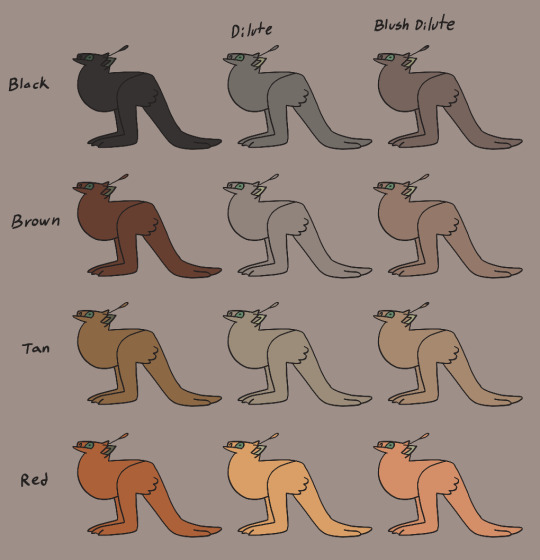
There are 12 categories of spring hound base coat colors, with 4 major color categories. Brown and tan are the most common, with black being a bit more uncommon and red being the rarest. The dilute gene is self explanatory, it lightens the color and patterning of the coat to varying degrees, nothing too flashy. The blush dilute is somewhat similar, but it impacts the pheomelanin less than the eumelanin, therefore it leaves a bit more of a rosy tone. The gene for dilute and blush dilute are both recessive, but it might show up again if the same type of dilute gene exists in both parents.
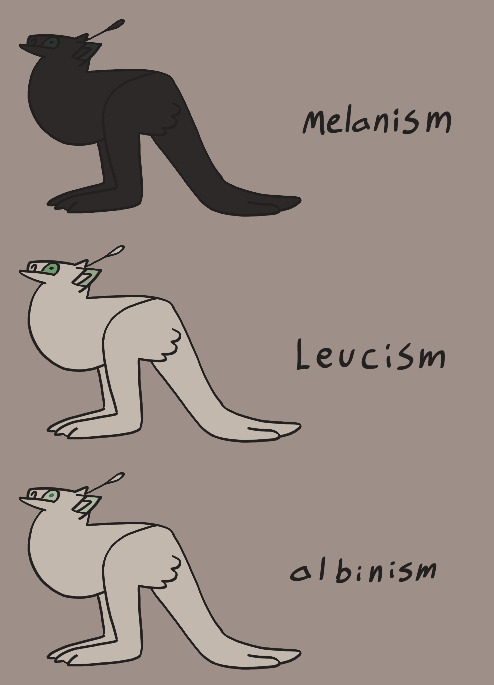
There are some other colors that are the result of genetic mutations. All white coats don't exist in spring hounds standard coat colors, but leucistic spring hounds are not uncommon, so it was assumed they were part of the standard array. Albinism and melanism are both rather rare, but melanism doesn't come with health issues like albinism does, outside of being more vulnerable to heat stroke in some regions. Spring hounds with albinism tend to be visually impaired or blind, and it also weakens their tusks enough to require a diet with less hard bones and shells.

The most common coat pattern is the colorpoint pattern. On earth, colorpoint cats have pigment in the warmest parts of their bodies. Spring hounds get pigment on the parts of their body that get the most sun exposure. This coat pattern comes about with age, and the amount of sun exposure they get in their early years has an impact on how dark their fur gets, along with genetics. Pigment shows up on the feet and under the tail because body heat does have some influence over where pigment shows up. This patterning frequently shows up along with other coat patterns, and most spring hounds will at least have a faint version of it under their stripes or splotches.
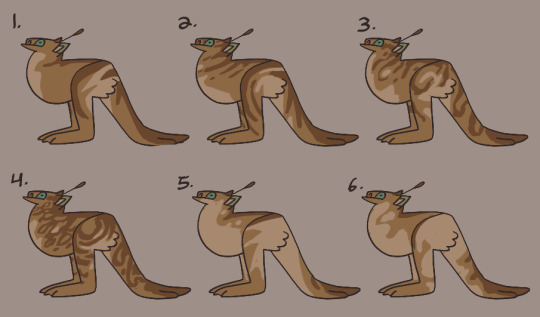
The other common coat pattern for spring hounds is stripes, but some patterns are less common than others.
The most common stripe pattern, feral populations would often revert back to this pattern after a few generations.
The same as above but with more intense striping.
The equivalent of a blotched tabby, it’s less common but not rare.
The same as above but with more intense striping, this is a very popular stripe pattern.
A much more rare version of the common striped pattern, with less striping and larger light patches.
A similarly uncommon version of the “blotched” stripe pattern with larger light patches.

The primary multicolored gene has a lot of color variety within it, with the gene causing specific pigments in the fur to either be greatly reduced or absent entirely. This exists in all fur coat genetics, but shows up a bit differently in all of them. Pigment loss tends to be concentrated on the underside of the body. Above are some examples of how this gene can change a spring hounds coat.
A lack of eumelanin, causing the affected fur to have a red to orange hue.
A complete lack of melanin, causing the effected fur to have a white hue.
A partial lack of melanin, causing the affected area to be a diluted tone, it can have a “blush” tone if the spring hound carries the gene for it.
An example of how the first version of the multicolor gene would look on a brown fur tone, the genes do not add pigment, so they change in accordance to the melanin ratios in each fur tone.

There can also be white spotting that goes along with this gene, here are a few examples of what that looks like on different variations of the multicolor gene.

Finally, here are some examples of different coat lengths. While these exist on a wide spectrum, they usually fall between 1 and 2. 3 is only really seen in breeds from polar regions and occasionally in mutts with the genetics for it. Short fur is seen as the most aesthetically pleasing, as it is easier to maintain and keep neat.
There are many, many combinations of all of these genes, giving spring hounds a wide variety of coats.
As for other physical features, the genetics are less clearly understood for a few reasons. Namely the fact they have not put much effort into recording the lineages of breeds.
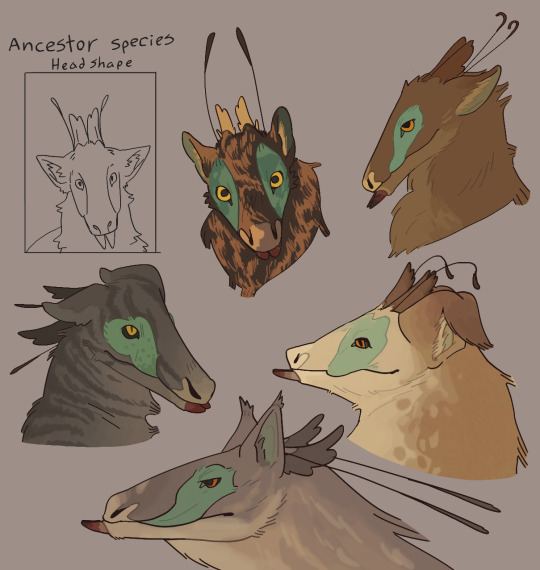
While there are no agreed upon breed standards, spring hounds have still changed in accordance to their jobs. Differences in appearance are either practical or purely incidental, breeding for specific traits for aesthetic reasons is more common in domestic fungi or plants. The image above is just a few examples of the variety of appearances.
Fun facts
They clack their beaks when they're content, it sounds a bit like this, but muffled.
A common play behavior is to nudge their companion with their tusks, which hurts BAD if they’re being rough or are running up to you before doing it. This is discouraged at a young age as to not cause any actual damage when they’re larger and stronger.
They’re mesocarnivores, with about 60% of their diet being meat.
Their favorite places to be pet are usually behind their ears, their cheeks, and the top of their back and tail.
#thank you my good friend cosmo for the name! and everybody who helped beta read this too!#spec bio#speculative biology#my art#worldbuilding#singers#ive been working on this for a bit over 5 months im finally done im free im alive and breathing fresh air#i feel like chell post portal 2
160 notes
·
View notes
Text
Inktober Days 7-9
Day 7: "Drip"
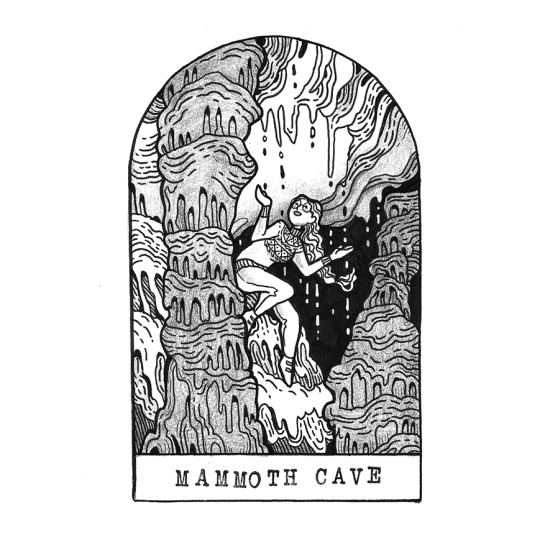
Can you believe we live in a world where the tiny drip-drip-drip of water can carve vast caves deep underground? To wander through Mammoth Cave—or any of the caves protected by the NPS—is to appreciate the power of water and time. Geologic formations aptly named flowstone and dripstone ripple, drizzle, and cascade in a mirror of the water that created them.
Touring Mammoth Cave is one of the earliest memories I have of visiting a national park. I remember squeezing through tight passages after my dad, as well as experiencing true, utter darkness for the first time when the ranger switched all the lights off.
Day 8: "Toad"
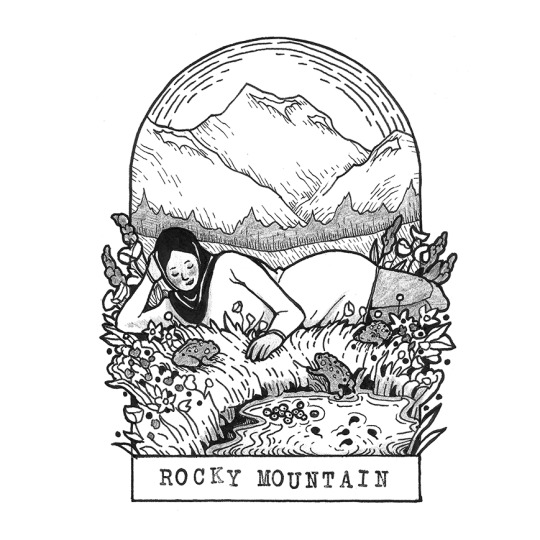
There’s something so grand about toads. Whether it’s a teeny little gentleman perched on a wet rock or a great gargantuan grandee lolloping along a muddy path, it always seems like a blessing to spy a toad. Perhaps it’s a holdover from childhood, when toads were some of the only wildlife we could get our hands on, cradling their squishy bodies and staring into their ever-grumpy faces.
Most parks in the NPS host toads, even ones where it might seem improbable. In the high, cold slopes of Rocky Mountain, the boreal toad can be found in wet meadows and ponds. It’s considered the only alpine toad in Colorado.
Because toads and other amphibians are so sensitive to their environments, they’re often considered indicator species of ecosystem health. Healthy toads mean healthy land, water, and air. Unfortunately, like many amphibians, boreal toad populations are in decline due to chytrid fungus, a disease that’s been decimating amphibian populations across the Americas, Europe, and Australia. Biologists in Rocky Mountain are carrying out important work to study and save their little high-alpine gentletoads from collapse.
Day 9: "Bounce"

Recently, when I was helping my brother move across the country, our plans went awry due to freak bad weather across the southwest. We diverted north and found ourselves in Arches National Park. It turned out to be the highlight of our whole trip. It was late winter, and the vibrant red rocks were ribbed with snow. The air was crisp, the panoramas of frosted mountains undisturbed by dust or haze. And the park was quiet, utterly so—I’ll always remember the silence of our campsite, broken only by the croaking of ravens and distant coyote song.
To cap it all off, pressed into the red sand around our site were dozens of little footprints—the hopping marks of kangaroo rats. They were like getting a postcard in the mail from a faraway friend. Hello, hello, hello. We’re out and about. Have a nice stay.
105 notes
·
View notes
Note
So I live in the Midwest. Recently they reintroduced red wolves in the state of Missouri which I thought was good but now they're releasing kangaroos in the state to deter predation of cattle and natural deer herds. Any thoughts?
Unfortunately, friend, you fell for an April Fools joke. Here’s the only result I can find when I search for that:
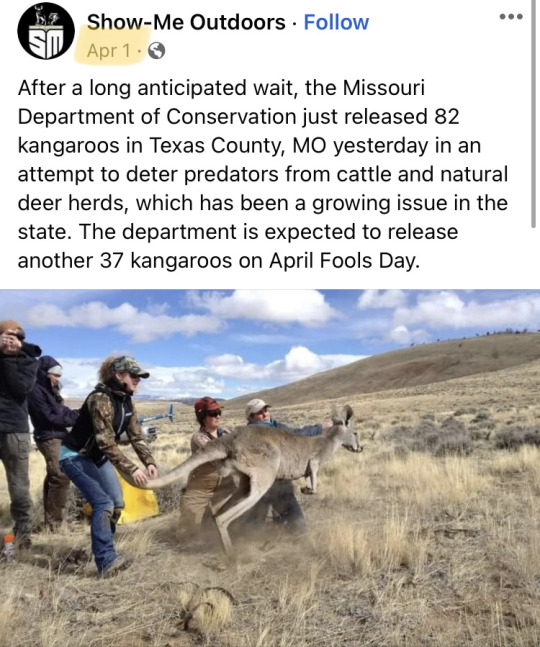
It’s a joke that’s shown up in other states for April Fools, too - here’s one for Wyoming from a few years back.
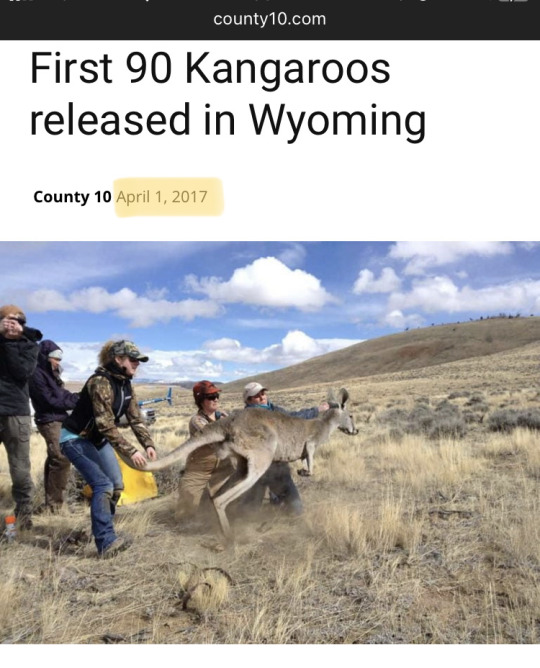
So nope, no kangaroo introductions into the US Midwest are occurring as part of wildlife management strategies.
UPDATE: also, another bit of misinformation to address here, the only current wild population of red wolves in the US is in North Carolina. It’s considered an “experimental” population and consists of individuals released from the captive breeding program, as they were deemed extinct in the wild in 1980. There’s a great, easy to read overview of the program and the current reintroduced population here.
543 notes
·
View notes
Text
by Brendan O'Neill
Now, not even Israel’s most fervent defenders would describe it as ‘spotless’. Like every state, it makes mistakes, it does wrong. But the showtrial of the Jewish State eerily echoes the showtrial of the Jew Dreyfus. Again we see the deployment of ‘lurid imagination’, where every single thing Israel does is pored over and judged nefarious. Again we see men – or in this case, nations – that are ‘lost in debts and crime’ projecting their own sense of guilt on to a Jewish scapegoat. And again we see not one nation this time, but many nations seeking to distract attention from their own inner turmoil through the creation of a spectacle of accusation – only now it’s not a Jew in the dock; it’s the entire Jewish nation.
We have heard quite enough of your lurid accusations against Israel. Now it’s time you heard ours against you. I accuse South Africa of joining the holy war against Israel in order to cynically curry favour with the woke elites of the West. In order to try to repair its global image as a just, radical nation despite its cataclysmic failing of its own population who still await the enrichment and equality they were promised following the fall of Apartheid 30 years ago. I accuse Iran of backing the legal crusade against Israel as a furtherance of its violent anti-Semitism. As yet another opportunity to defame and isolate the Jewish State in order that the Jews there might feel compelled to leave.
I accuse Turkey of backing the showtrial in order to disguise its own past genocidal crimes. In order to pool its genocidal guilt, and project it on to others, in particular the supposedly evil ‘Zionist entity’. I accuse Turkey of spying in these kangaroo proceedings an opportunity to rearrange power relations in the Middle East to its own tyrannical advantage. To strengthen the Turkey-Iran alliance on the back of what they hope will be the international court’s reprimand of the Jewish State. I accuse Turkey of sacrificing the safety of Jews in Israel at the altar of its own demented regional ambitions.
And I accuse the Western left of being the running dogs of all this global Israelophobia. Of forfeiting their right to be treated as serious moral actors by aligning with the demagogues, Islamists and outright racists who have dragged the world’s only Jewish nation to court on the most trumped-up charge imaginable. Of flagrantly abandoning their supposed commitment to anti-racism by whitewashing Hamas’s orgy of racist violence that gave rise to the current war. And of emboldening the fascists of Hamas by promoting the libel that says Israel is a genocidal state. After all, if Israel is guilty of the worst crime known to man, why should Hamas not attack it again, and again, and again, until the Nazi-like threat it poses to the Palestinian people has been eradicated? I accuse you of giving moral succour to fascists.israe
#genocide#international court of justice hypocrisy#captain alfred dreyfus#dreyfus affair#j'accuse#turkey#iran#south africa#israel
31 notes
·
View notes
Note
"a revival of unofficial vigilante death squads targeting gang members" ...you have said in the past that you dislike vigilantism. Is Bukele's solution, whereby criminal scum are tried and incarcerated according to the law, not preferable to them being extrajudicially killed, or killing one another in underworld skirmishes?
Bukeles solution is very much not trying and incarcerating criminals "according to the law:" the current crackdown has been enabled by a continually renewed state of exception starting in match 2022, specifically to deprive accused criminals of civil liberties and procedural protections like a right to legal counsel. Many now imprisoned have received no trial, and the "trials" others have received have frequently made a mockery of the title, like trials with few to no witnesses. The govt has paved the way in the future for even more egregious violations of basic principles of due process, like mass trials of up to 900 defendants. It is not possible to incarcerate 1.6% of the population in a matter of a few years without resorting to kangaroo courts, and everyone—even bukeles defenders—admits that this is what is going on
Its tricky to get any concrete numbers on killings by sombra negra and other possible vigilante groups during the recentcrime wave, but at their height in 1995 they seem to have numbered in the dozens before quickly tapering off. Compare to prisons under bukele, where in the first year alone the death toll in custody from bukeles mass incarceration campaign was confirmed to be at least 154, which will doubtless only increase as the crackdown continues and the prison numbers swell. As bad as extrajudicial vigilante death squads are, the transformation of the courts and prisons into instruments of pure repression has been even worse
Given the alleged overlap between sombra negra and the salvadoran police, its questionable just how much we should distinguish them from the current regime itself, particularly when the cops snd criminal justice system are permitted to enforce their will as lawlessly as they have under bukele
27 notes
·
View notes
Text

[ Pepijn Kamminga holds the only Attenborough's long-beaked echidna museum specimen in the world. ]
"Until now, the only evidence that this particular species 'zaglossus attenboroughi' existed was a decades-old museum specimen of a dead animal.
"I was euphoric, the whole team was euphoric," Dr James Kempton told BBC News of the moment he spotted the Attenborough echidna in camera trap footage.
"I'm not joking when I say it came down to the very last SD card that we looked at, from the very last camera that we collected, on the very last day of our expedition."
Dr Kempton headed a multi-national team on the month-long expedition traversing previously unexplored stretches of the Cyclops Mountains, a rugged rainforest habitat more than 2,000m (6,561ft) above sea level.
In addition to finding Attenborough's "lost echidna" the expedition discovered new species of insects and frogs, and observed healthy populations of tree kangaroo and birds of paradise.
Aside from the duck-billed platypus, the echidna is the only mammal that lay eggs. Of the four echidna species three have long beaks, with the Attenborough echidna, and the western echidna considered critically endangered.
Previous expeditions to the Cyclops Mountains had uncovered signs, such as 'nose pokes' in the ground, that the Attenborough echidna was still living there.
But they were unable to access the highest reaches of the mountains and provide definitive proof of their existence.
That has meant that for the last 62 years the only evidence that Attenborough echidna ever existed has been a specimen kept under high security in the Treasure Room of Naturalis, the natural history museum of the Netherlands."
- Excerpt from "First ever images prove 'lost echidna' not extinct" by Jonah Fisher and Charlie Northcott.
43 notes
·
View notes
Text
In addition to finding Attenborough's "lost echidna" the expedition discovered new species of insects and frogs, and observed healthy populations of tree kangaroo and birds of paradise.
Aside from the duck-billed platypus, the echidna is the only mammal that lay eggs. Of the four echidna species three have long beaks, with the Attenborough echidna, and the western echidna considered critically endangered.
49 notes
·
View notes
Text
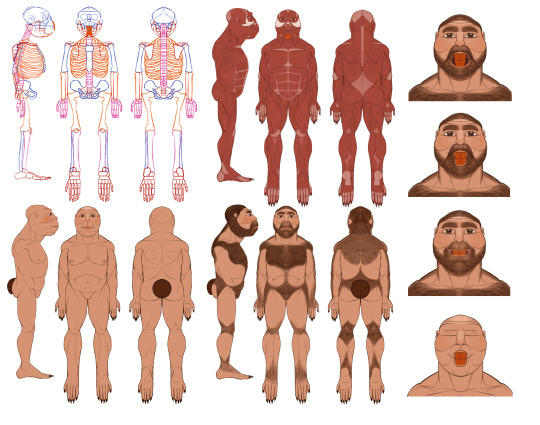
An introduction to Castor erectus:
Castor erectus, common name "Mountain Dwarf" is member of Castorimorphia, a suborder of rodents that consists of the superfamilies Castoroidea, (Modern Beavers) and Geomyoidea (Kangaroo Rats).
In our current timeline, the genus Castor has only two extant members, Castor canadensis, common name "North American Beaver", and Castor fiber, common name "Eurasian Beaver".
Castor erectus offers an alternate evolutionary history where Beavers evolved to fill human-like niches. Their look and culture are heavily inspired by the stories of Dwarves as told in fantasy epics such as Lord of the Rings, as well as stories of dwarves from Germanic folklore. Their design is meant to be unique enough to offer an interesting history and flavor for Dwarves, while still being familiar enough to be recognizable as Dwarves.
Castor erectus stands at an average of 4'5", with specimens varying in height by +/- 4 inches (for healthy adults.) Female dwarves are on average 3 inches shorter than their male counterparts.
Castor erectus shows little to no sexual dimorphism. (You may have seen my previous sexual dimorphism model, this was based on my incorrect assumption that strong sexual dimorphism was present across most mammals.) Modern beavers lack external genitalia, a trait that is present in Castor erectus, which makes it difficult to distinguish a Dwarf's sex. Members of the species can easily distinguish the sex of other members through smell, though their culture does not place a heavy emphasis on gender. The Dwarven language lacks gendered pronouns, and sexuality among Dwarves is incredibly fluid. Same sex pairings can be a helpful evolutionary tool, allowing communal-living social species to meet the social and sexual needs of its' members, without increasing population of their colony to an unsustainable size.
Dwarves typically live in large colonies constructed in and around mountain cave systems. These structures are known as Lodges, which are an evolved form of modern beaver habitats. The construction of these lodges generally begins with the construction of a large cistern, and a canal below the snowcap of their home mountain which diverts runoff into the cistern for collection. They use this collected water to fuel primitive aquaponics and hydroponics systems in their lodges. Dwarves are often separated into small familial groups, but it is not uncommon for distantly related groups to merge into a single colony to control resources and water.
In the future, I will be posting more illustrations and writings detailing Dwarven Culture, as well as exploring their evolutionary history through extinct relatives. If you have any questions about their culture or anatomy in the mean time, feel free to ask! Any amount of feedback helps to flesh them out and answer questions I might not have otherwise thought of.
#dwarves#dwarf#speculative anatomy#speculative zoology#speculative biology#spec bio#specbio#fantasy art#evolution#anatomy#digital art
37 notes
·
View notes
Text
Canis dingo, or maybe Canis lupus dingo, or maybe Canis familiaris dingo
Some researchers think dingoes are an ancient breed of domesticated dogs brought to Australia around 4,000 years ago by Asian seafarers. Others think they are a distinct species closely related to grey wolves and domestic dogs, similar to coyotes and jackals.
Either way, dingoes are very closely related to wolves and domestic dogs and are able to interbreed with them. Most dingoes in Australia now are mixed with many different dog breeds. One of these dingo-dog hybrids is the Australian cattle dog, which is a pretty popular dog breed used for herding cattle.
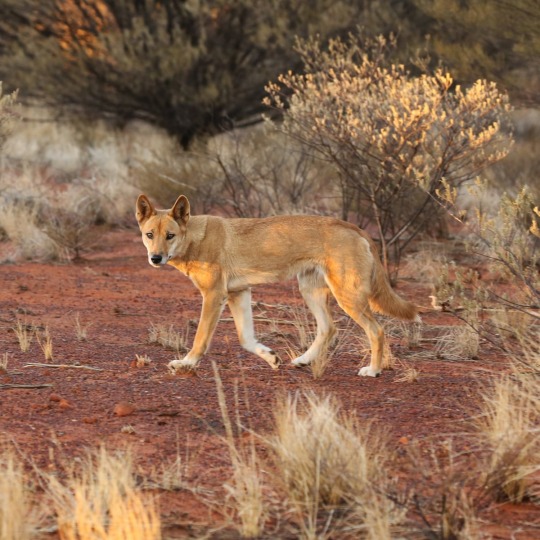
Dingoes are found in every state of Australia except for Tasmania. The dingo’s relative, the New Guinea singing dog, is also found in the mountains of New Guinea. Named for their unique yodeling howls, singing dogs are one of the most endangered canines in the world. They were believed to be extinct in the wild until a small population was found two years ago.

Those that live in the high Alpine habitats of southeast Australia are known as Alpine dingoes. They are often lighter in color and grow thicker coats than those that live in desert or forest habitats. Desert dingoes that live in northern Australia are the typical bright orange color. They are larger than other dingoes, generally weighing around 40 pounds (18 kg) with some reaching over 50 pounds (22.7 kg). There are dingoes that live in forests and have dark tan or black fur, but they are most likely not purebred.
Fraser Island off the east coast of Australia is home to around 200 dingoes. With no pet dogs on the Island, they are purebred. Fraser Island and Alpine dingoes are possibly the last populations that are not mixed with domestic dogs.
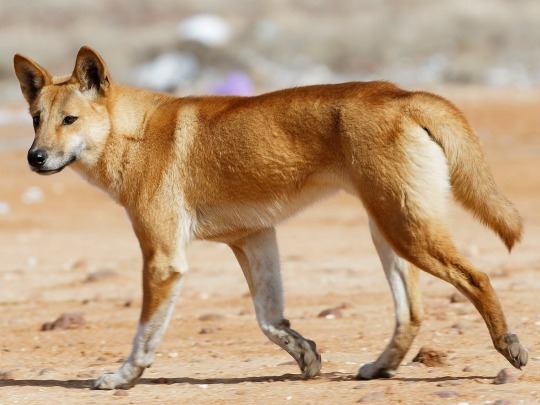
Often living in packs of up to 12 individuals, dingoes are very social. The dominant male and female of these packs are the parents of all the others. They rarely bark to communicate with each other, instead using a variety of howls.
In areas with small prey like hares, rodents, and reptiles, dingoes generally hunt alone. They still might live in packs, but they only rest and play with each other. In areas with larger prey like kangaroos and sheep, they hunt as a pack. Their tendency to hunt sheep causes farmers to target them, so the dingo population is classified by some as vulnerable but by others as endangered due to poisoning, trapping, and shooting.
Dingoes hunt by ganging up on larger prey with multiple pack members or by scaring small prey out of thickets and then pouncing. They are very flexible so they can follow prey into tight spaces. Like a cat, if a dingo’s head can fit through something, its whole body can.
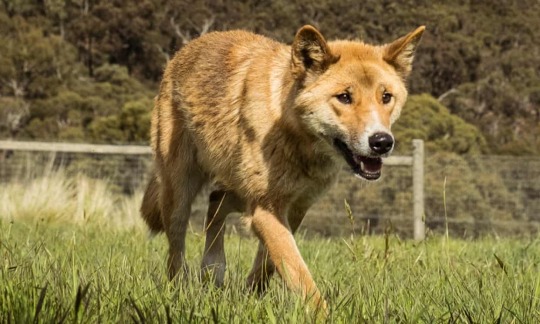
Wandi ^
I would also like to mention Wandi, who is a very good dingo. He was dropped by an eagle into a backyard when he was 5 weeks old. It was discovered soon after that he was a rare alpine dingo, so he went to live at the Dingo Discovery Sanctuary and Research Centre. He’s helping protect the species and he even has his own Instagram account.
I rate the dingo 17/10. A very Australian animal
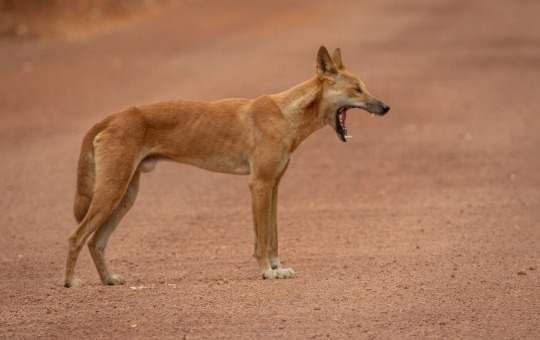
Photo credits:
(1) Jamie Lamb (2) Michelle J Photography (3) Michael Hains (4) Christopher Hopkins (5) tanyahattingh
#dingo#wild dog#Australia#animals#biology#nature#science#wildlife#zoology#animal#dog#dogs#wild#dingoes#wild dogs#canines#canids#canine#wolf#wolves
304 notes
·
View notes
Text




Sketches of a so far unnamed creature. These house cat descendants weight over 170 kilograms and are specialized for hunting vertebrate prey of similar size. They hunt by chasing the prey down, restraining it with their front paws and finally killing it with a strong bite.
When their ancestors, the house cats, started exploiting a niche of a small, arboreal predator, one of them had a nanite mutate its forelimb claws in such a way that they were slightly more opposable. This individual passed it down to their offspring, because it happenned to be an advantage for climbing and prey capture. As the time passed and the ecosystem stabilized more, their population began to grow larger as larger prey established their own populations in the rainforests. At this point, their ancestors weighted circa 60 kilograms. Due to their diet shifting to a larger sized prey, they slowly abandoned the tree canopy, but still climbed on their daily basis. One branch of these moderately sized felines would slowly become more and more social, using their opposable thumbs for grabbing rather than restraining. This lineage will be very important later on, as they will be one of the few lineages to develop their own culture. The other “moderately big tree feline” branch stayed relatively solitary, moved into a more open habitat and their role shifted to a fast predator and grew even larger. The shift wasn’t as extreme, as these animals retained long, muscular tails and strong thighs from their pouncing-climbing ancestor, these body parts only changed their purpose and further specialized, resulting in a kangaroo-like body plan and jumping then replaced sprinting and they lost the ability to rectract claws on their hind paws.
When they moved out of the safety of the rainforest, they weren’t the top predators. There was another, very large creature. Its scaly, colour changing body towered over every single carnivore of its time. The colour change was very important for communication, especially red appearing around the face area, which signalized aggression. Our red faced felines back then weren’t quite red faced yet, this adaptation developed as a defense mechanism against these reprilian predators. Its goal was to confuse the squamate for a brief moment, allowing the feline to get a headstart when escaping. These mammals cannot see red, and neither can their prey, so this adaptation had little to no impact on their hunting. Even though that reptilian predator had gone extinct few milions of years ago, the red face on our felines is still their characteristic signature.
#speculative evolution#creature design#digital art#worldbuilding#artists on tumblr#spec bio#spec evo#speculative fiction#sketch#animal design#worldbuilding project#scifi worldbuilding
27 notes
·
View notes
Text
Today in Things This Shitshow Has Unearthed About Isn'treal And Its Kangaroo Court Alliance. (Please stand away from any surfaces you would feel compelled to bring your head into violent contact with).
Transcribed Twitter thread from Mouin Rabbani.
To understand why International Criminal Court (ICC) Prosecutor Karim Khan’s conduct regarding “The Situation in Palestine” is so scandalous and should disqualify him from office, a little background is necessary.
Israel has not ratified the Rome Statute, and is not a State Party (i.e. member state) of the ICC (International Criminal Court), the global tribunal established in 2002 to hold accountable perpetrators of war crimes, crimes of aggression, crimes against humanity, and genocide. Of specific concern to Israel was that the Rome Statute, in Article 8.2.(b).(viii), defines as a “war crime” the “transfer, directly or indirectly, by the Occupying Power of parts of its own civilian population into the territory it occupies, or the deportation or transfer of all or parts of the occupied territory within or outside this territory”. This closely reflects Article 49 of the IV Geneva Convention of 1949 Relative to the Protection of Civilian Persons in Time of War, which defines such activities as a “grave breach”, the Convention’s equivalent of a war crime. Other articles, such as 7.1.(j) which defines “apartheid” as “a crime against humanity”, became a serious concern more recently, as the longstanding judgement of Palestinians on this matter was endorsed by the leading Israeli and international human rights organizations.
The ICC is only empowered to prosecute individuals, not states. (The conduct of states is adjudicated by the International Court of Justice, the ICJ, a separate institution also located in The Hague). The Office of the ICC Prosecutor can conduct investigations into alleged violations of the Rome Statute only if either 1) a case is referred to the ICC Prosecutor by the United Nations Security Council (UNSC), 2) requested by at least one ICC member state, or 3) initiated by the Prosecutor, provided it is authorized to move forward by a panel of ICC judges known as the “pre-trial chamber”.
Given that the US, which like Israel refused to join the ICC, has veto powers at the Security Council, and that Palestine was not an ICC member, Israel was not particularly concerned that the ICC Prosecutor would independently seek to initiate an investigation of its conduct.
So it sufficed with periodic tirades dismissing, demonizing, and delegitimizing the Court. That began to change in 2015 when Palestine, which has the status of Permanent Observer State at the UN, was admitted to the ICC and permitted to formally ratify the Rome Statute. The Palestinian leadership had for many years stalled on this and other initiatives promoting the application of international law to the Palestinians. This was, parenthetically, not out of fear of potential ICC prosecutions of Palestinians. Hamas, whose members are the most likely to be prosecuted if the ICC investigates Palestinian violations, in fact called for Palestine’s accession to the ICC, in both word and writing. In writing, because Hamas propaganda had been denouncing Abbas for promoting Palestine’s ICC application at a snail’s pace out of fear of the Israeli and Western response. Abbas responded by insisting that Hamas and Islamic Jihad sign a document supporting the application before it was submitted, so he could not later be accused by them of joining the Court in order to have his rivals extradited to The Hague.
When the deed was done, Palestinians from across the political spectrum welcomed it, and stated they were prepared to see all alleged violations of the Rome Statute committed in Palestine investigated by the ICC.
Hamas’s criticisms of Abbas may have been propaganda, but they were also correct. Israel and its US and European sponsors had from the outset made clear their opposition to Palestine seeking to join the ICC, and demanded that it desist. The Europeans, who unlike the US and Israel have joined the ICC, were in a particular pickle. As a European diplomat stated to me at the time: “We don’t want the Palestinians to put is in a position where we have to choose between our commitment to international law and our commitment to Israel”. In other words, they didn’t want to expose the rotten core of their rules-based international order, where the rules only apply to everyone else. When they failed to prevent Palestinian accession, Israel in particular went berserk. It began withholding Palestinian taxes it was legally obliged to transfer to the Palestinian Authority, imposed a variety of restrictions on Palestinian officials, and threatened to punish the PA in multiple additional ways. The US also made its displeasure clear, but directed the brunt of its retaliatory measures directly at the ICC. Washington at one imposed sanctions on Khan’s predecessor, Fatou Bensouda, normally reserved for designated criminals. It was Washington’s way of informing the ICC it had no right to investigate either Israel’s crimes against the Palestinians or US conduct in Afghanistan. In 2002 the US had already adopted legislation known as The Hague Invasion Act, which authorizes the US military to invade The Netherlands, a fellow NATO member, and free any US citizen in ICC custody.
(Not clear how NATO’s collective defense provisions enshrined in Article 5 would operate under such circumstances.)
The Europeans, duplicitous as ever, kept confirming their support for the ICC while submitting vacuous legal arguments to the Court insisting it had no jurisdiction over Palestine. In doing so they came within a hair of endorsing Israel’s position that the ICC is an illegitimate body. The Dutch government for its part indicated it could not take a position on the matter because as the state that hosts the ICC, it was obliged to preserve its neutrality in such matters. Yet several years later it demonstratively awarded the ICC several million Euro to support its investigation of Russian conduct in Ukraine, an initiative it repeatedly and publicly endorsed.
In the event, the Palestinians in 2015 submitted an application to the Office of the ICC Prosecutor to investigate violations of the Rome Statute in the Palestinian territories occupied by Israel in 1967, beginning in 2014. The Court wasted years adjudicating matters of jurisdiction and competence, before finally confirming, in 2021, that it had a mandate to conduct an investigation.
Which brings us back to the scandal known as Karim Khan. In previous functions, for example investigating the Khmer Rouge genocide in Cambodia and that by ISIS in Iraq, he developed a reputation as an attention whore of sorts. Didn’t achieve much by way of results, but always found his way to the television cameras. A British citizen, his candidacy as ICC Prosecutor was energetically supported by the UK government. His candidacy was also championed by the US and Israel, two non-member states opposed to the very existence of the Court. In 2021, Khan narrowly won election to a nine-year term. Unless he’s forced out, we’re stuck with him until 2030. Some held the forlorn hope that Khan would prioritize efforts to revive the ICC’s stature and reputation, which by the time he took office was being widely derided as the “International Caucasian Court” and “International Criminal Court for Africa”, on account of the cases it chose – and chose not to – prosecute. In protest at such biases, South Africa at one point temporarily renounced its ICC membership.
In practice, Khan wasted no time aligning his agenda with that of his sponsors. Almost immediately, he informed the UN Security Council that he would prioritize only those cases referred to him by the Council and essentially ignore the rest. The ICC Palestine investigation, such as it was, effectively ceased to exist. Yet when Russia invaded Ukraine in 2022, which the UNSC could not have referred to the ICC for investigation because of Moscow’s power of veto, Khan immediately reversed course on his previous commitments. It took him only a week to pop up in Kiev, informing any and every journalist within a 100-mile radius that his investigation was already active. A little over a year later he indicted none other than Russian President Vladimir Putin.
Throughout this period, the ICC’s Palestine investigation remained non-existent. There was considerably less spring in his step as the latest crisis in the Middle East erupted on 7 October. It was only at the very end of October that he took the trouble to visit the region. Claiming he had been denied entry to the Gaza Strip, he spoke to the assembled media in Cairo, where he delivered a lengthy and impassioned denunciation of the 7 October Palestinian attacks, announced his availability to work with the Israeli authorities to prosecute those responsible for violations of the Rome Statute on that day, yet pointedly refrained from any reference to Israeli war crimes, which his predecessor Bensouda had already in 2019 announced were being committed. Rather, his message to Israel was of a more general nature: that it had clear obligations under international law and would be held accountable for (unspecified) violations. Khan further, and disingenuously, claimed that in 2021 he established the “first dedicated team to investigate the Palestine situation”. Even though this team has in contrast to that sent to investigate Russian conduct in Ukraine never been referenced or heard from, Khan on 3 December stated he would “further intensify” its efforts.
But this was nothing compared to his next visit, undertaken in early December to Israel in coordination with the Israeli government which, it needs to be emphasized once again, has rejected the legitimacy of the ICC, launched extensive campaigns of vilification to delegitimize it, and has consistently obstructed its efforts to investigate Israeli conduct vis-à-vis the Palestinians. Initially described as an “unofficial” visit (perhaps he entered the country wearing a disguise designed for Inspector Clouseau by Auguste Balls), he accepted Israel’s rejection of a visit to the Gaza Strip as a condition for meeting with Israeli families who lost loved ones on 7 October. In an effort to conceal and whitewash this dirty deal, he at the end of his visit took a short trip to Ramallah to meet with PA President Abbas. Seeing through his agenda, Palestinian human rights organizations unanimously refused to meet with him, and denounced his visit.
The most problematic aspect of Khan’s visit was his concluding statement. While claiming his trip was “not investigatory in nature”, he nevertheless allowed himself to establish, as a matter of settled fact, that the attacks of 7 October “represent some of the most serious international crimes that shock the conscience of humanity”, for good measure denouncing Hamas as a “terror organization”. If Khan had denounced Israel and its crimes against the Palestinians with similar polemics and conviction, this would have multiplied rather than limited the damage inflicted by Khan. This is for the simple reason that the ICC investigation, if it indeed exists, is still in its initial stages, yet the prosecutor has already announced its conclusions.
In the event Khan had a very different take on Israel’s conduct. Addressing the slaughter of thousands of children and razing of entire neighborhoods to the ground, he went no further than to assert that “credible allegations of crimes” that may – or may not – have been committed, should be “the subject of timely, independent, examination and investigation”. With respect to Israel shutting off the food, water, medicine, and fuel supply to the Gaza Strip, an assessment of which requires no more than a diploma in basket weaving, he would not go beyond insisting that the supply had to be guaranteed, and “must not be diverted or misused by Hamas.” Gleefully skipping over the patently genocidal statements of Israeli leaders that might have helped him connect the dots he, much like Western politicians, took the easy way out and instead denounced the violence of Israel’s settlers, as if these form an independent vigilante force rather than auxiliary militia implementing state policy.
The reason Khan tread so lightly also reflects what appears to be the most disturbing element of his agenda. Pursuant to the Rome Statute the ICC only prosecutes cases where national authorities have demonstrably failed to ensure accountability. In this context, every examination of Israel’s judicial system with respect to violations of Palestinian rights, has concluded that it is essentially a sham, and exists to provide legal justification for such violations and/or exonerate perpetrators. Yet Khan emphasized that he stands “ready to engage with relevant national authorities [i.e. Israel] in line with the principle of complementarity at the heart of the Rome Statute”. In other words, Khan will prosecute Palestinians, and Israeli violations will be adjudicated by Israel’s court system. Both with predictable results.
In order to keep this short, I conclude with posting an article @hasmikegian and I recently wrote for @PassBlue on why Karim Khan is not fit for purpose. I am also indebted to her for multiple insights and substantial input into this thread.
https://www.passblue.com/2023/11/28/is-the-icc-prosecutor-karim-khan-fit-for-purpose/
My head has been in my hands almost constantly the last two months, but understand this: the fact that this stuff is finally FINALLY coming to the attention of the broader international public is a WIN. It's a win that's taken about twenty thousand people dead and still more dying to achieve, which means its all the more reason we are obligated to NOT give up on the rest of the victims of this horrible colonial world order, both in and beyond Palestine. The world failed Palestinians for seventy five years, and for seventy five years they could not stop hoping because giving in meant accepting annihilation. We have not earned the right to succumb to despair, and if we do, we too deserve no less.
(This post is not for pro-Russia/ pro-China Tankies to use the suffering of Palestinians to whitewash your own favourite genocidal imperialist. GTFO.)
#free palestine#israel is a terrorist state#israel is an apartheid state#gaza genocide#palestinian genocide#war crimes#international criminal court#mouin rabbani#world politics#karim khan#geneva convention#ICC#the hague#united nations#fuck the USA#western imperialism#western hypocrisy#colonization#colonialism#ceasefire now#rome statute#mahmoud abbas#fuck the UK#white supremacy#knee of huss
13 notes
·
View notes
Text
Is it true kangaroos are such an invasive and overpopulated species that killing them is encouraged by the government? I heard that somewhere but I’m too lazy to google. the other thing I heard is that they’re so ecologically damaging even Aussie vegetarians will eat them because it’s a positive to reduce their population. That one sounds more suspect to me
18 notes
·
View notes